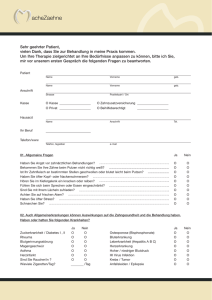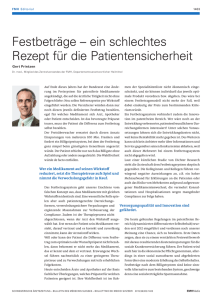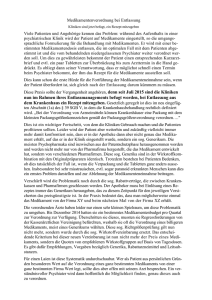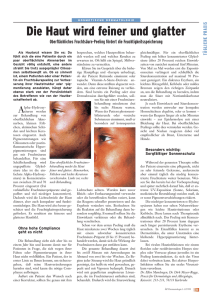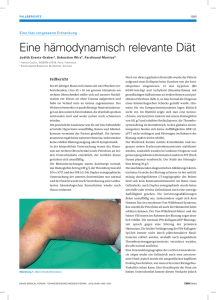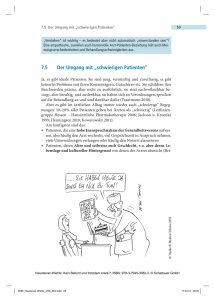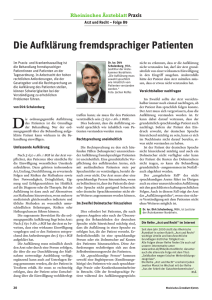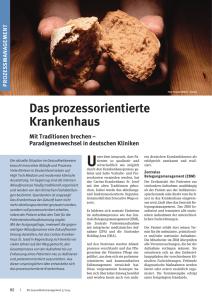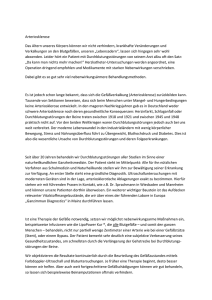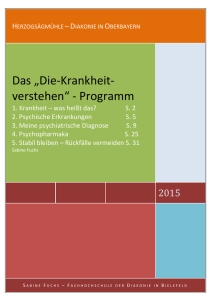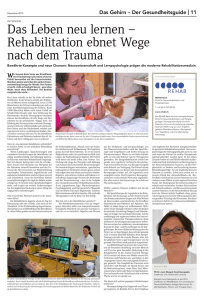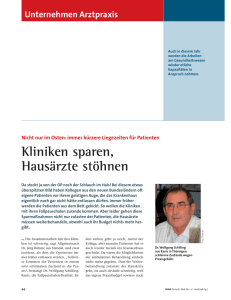Spiron
Werbung
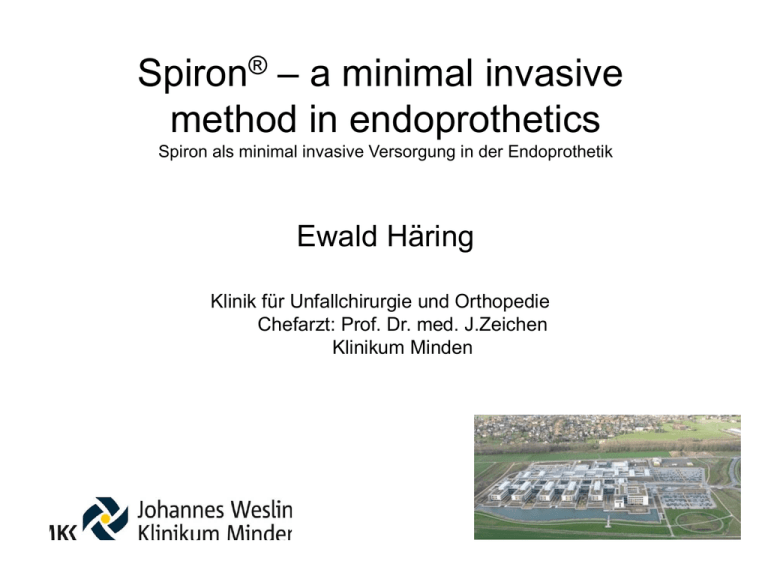
Spiron® – a minimal invasive method in endoprothetics Spiron als minimal invasive Versorgung in der Endoprothetik Ewald Häring Klinik für Unfallchirurgie und Orthopedie Chefarzt: Prof. Dr. med. J.Zeichen Klinikum Minden Clinic Minden, Germany Spiron idea: the pre-prothesis Indications for Spiron-prothesis Indikationen für die Spironprothese • coxarthrosis in patients with younger age Coxarthrose bei Patienten im Jungen Alter. • aseptical necrosis of femoral head Aseptische Nekrose des Hüftkopfes / Femurkopfes • older patients without defects or pre-operations at femor Patienten im Alter ohne Defekte am Knochengewebe Minimal invasive approaches for hip arthroplasty Minimal invasive Zugänge zum Hüftgelenk • frontal vorderer • anterolateral anterolateraler • transgluteal transglutealer • dorsal dorsaler • Medial mediale The antolateral approach was described already in 1884, later it was modified by Watson-Jones, mainly for the operation of neck fractures Der anterolateraler Zugang wurde bereits im Jahr 1884 beschrieben, später wurde dieser durch Watson-Jones modifiziert ins besondere zur Versorgung der Schenkelhalsfraktur. Röttinger 2006 Anterolateral approach acc. to Röttinger Anterolateraler Zugang nach Röttinger Между M .gluteus medius и M.tensor fasciae latae Positioning of the patient Lagerung des Patienten The frontal minimal invasive approach Der vordere minimal invasive Zugang View on femoral head Sicht auf den Hüftkopf Hip components Hüftkomponenten Acetabular cup Pfanne Inlay Inlay Stem Schaft head Hüftkopf SPIRON Prosthesis SPIRON Prosthesis Hüftkopfresektion femoral head resection View on capsule Sicht auf die Gelenkkapsel Insertion of acetabular cup Das einsetzen der Pfanne Sicht auf das natürliche Acetabulum Vorbereitung des Acetabulums Preparation of Acetabulum View at natural acetabulum Künstliche Pfanne acetabular implant SPIRON Prosthesis Drilled hole for Spiron Bohrung für die Spironprothese Vorbohren des Schenkelhalses für die Spironprothese, kein Raspeln pre-drilling of Spiron hole no rasping SPIRON Prosthesis Insertion of Spiron. Self cutting thread Das einbringen der Spironprothese (selbstschneidendes Gewinde) Spiron and head Komponenten Zusammensetzung Spiron & Hüftkopf Preoperative planning ist recommended! Präoperative Planung ist sehr wichtig Patient, male 56y Patient männlich 56 Jahre SPIRON Prothesis Optional control with c-arm Optionale C-Bogen Kontrolle mit Ausrichtungsstab ist möglich Patient 56y, male SPIRON Prosthesis Patient, 52 y., female Patient weiblich 52 Jahre SPIRON Prosthesis Patient, 52y.,female two sided Spiron prosthesis Patient weiblich 52 Jahre beidseitige Versorgung mit Spironprothese SPIRON Prothesis Patient, female, 59 y, two sides Patient weiblich 52 Jahre beidseitige Versorgung mit Spironprothese SPIRON Prosthesis Мale. 49y. Patient Patient männlich 49 Jahre SPIRON Prosthesis Patient, male, 48y Patient männlich 48 Jahre SPIRON Prosthesis Patient, 48y SPIRON Prothesis Patient, 48y SPIRON Prosthesis Patient, 48 y SPIRON Prosthesis Example of Revision with conventional hip Beispiel einer Revision mit einer konventionellen Hüftprothese SPIRON Prosthesis Patient, male, 41y Patient 41 Jahre, beidseitige Versorgung mit einer Kurzschaftprothese SPIRON Prosthesis Patient, male, 48y Patient männlich 48 Jahre Advantages of Spiron Vorteile der Spironprothese • minimal invasive surgical technique Minimal invasive Opertionsmethode • early mobilisation of patient is possible Frühere Mobilisation des Patienten ist möglich • short operation time Verkürzte Operationsdauer • no touch of femoral distal canal: preservation of bone Kein aufbohren des Knochenkanals (Vaskularisierung bleibt erspart) • good fixation Sichere Fixierung bei Osteoporose Possible complications similar to conventional arthroplasty Standart Komplikationen, wie bei einer Konventionellen Hüftoperation sind möglich • damage to nervs and blood vessels Schäden an Blutgefässen und Nerven • thrombosis and lung embolia Thrombose und Lungenembolie • infection Infektion • secondary sintering / loosening Sekundäre Verschiebung / Lockerung • fracture and cracks less than convetional Rissbildung und Bruch geringer als konventionell • luxation less than conventional Luxation geringer als konvetionell Benefits for the bone • Preservation of the bone stock • Proximal loading • No dysbalance of the muscle tension with reconstruction of the offset • Excellent precondition for revision, if necessary • Preservation of the elasticity of the femur Pic.:Sulzer Orthopedics. The stelcor system for minimal bone resection.Sulzer Medica. 1999: 1 problem: dysbalance of muscles Most hip stems have a CCD-angle of about 135° This is more than the natural angle of the proximal femur! – Result: the offset gets too small – This leads to an instability of the joint Dysbalance of the muscles increase the wear! Pic.: Pepino F. et al.: Preservation of femoral neck in hip arthroplasty: results of a 13-to 17-year follow-up. J Orthopaed Traumatol (2000) 1: 31-39 1 year after implantation Coxarthrosis – Implant types Femoral neck prosthesis Short stemprosthesis cementless Standardprosthesis Cemented Standardprosthesis Spiron Nanos CLS Spotorno M.E. Müller straight stem Coxarthrosis – Which Prosthesis for which patient? Coxarthrose – Welche Prothese für welchen Patienten? Age Alter BMI Contra indication Kontraindikation < 55-60 < 60 < 70 No limitation Keine Einschränkung active Patient active Patient < 30 < 30 Any osteoporosis Any osteoporosis Jegliche Osteoporose Jegliche Osteoporose Preoperations Preoperations Voroperationen Voroperationen pathological Hipgeometry pathological Hipgeometry pathologische Hüftgeometrie pathologische Hüftgeometrie No limitation No limitation Keine Einschränkung Keine Einschränkung moderate osteoporosis mäßige Osteoporose Expected revision Zu erwartende Wechseloperation Hard hip dysplasia Schwere Hüftdysplasie Advanced femoral head necrosis Fortgeschrittene Femurkopfnekrose Condition Vorraussetzung cooperative patient cooperative patient Kooperativer Patient Kooperativer Patient 3 weeks part. weight b. 6 weeks part. weight b. 6 Wochen Teilbel. 6 Wochen Teilbel. 3 weeks partial weight bearing 3 Wochen Teilbel. Full weight bearing Vollbelastung Actual study started 2011 in Klinikum Minden Aktuelle Studie startete 2011 im Klinikum Minden DRKS-ID:DRKS00003293 Registrierungsdatum 29.02.2012 http://www.drks.de/DRKS00003293 Deutsches Register klinischer Studien It will be executed a pre-investigation of the patients and a follow-up after 3 months & 1 year after Harris Hip score (doctor sheet) Oxford-Hip-Scores (Patient sheet), EQ5D und SF36. Es erfolgt eine Voruntersuchung der Patienten und eine Nachfolgeuntersuchung nach 3 Monaten & 1 Jahr nach Harris Hip score (Arztbogen) Oxford-Hip-Scores (Patientenbogen), EQ5D und SF36. http://apps.who.int/trialsearch/trial.aspx?trialid=DRKS00003293 Results of study „Koblenz 2001-2004“ Resultate der Studie „Koblenz 2001-2004“ n = 56, 29 m , 27 f n = 56, 29 ♂ , 27 ♀ 2/2001 – 5/2004 Follow-up 5 years HHS, x-Ray 1,3,5 years classical surgical technique Klassische OP-Technik Age distribution Study „Koblenz 2001-2004“ [%] 10 9 8 7 6 5 4 3 2 1 0 1 40 11 50 [Years] 21 60 31 70 Harris Hip Score 1 / 3 / 5 years post op 100 94,0 90 94,3 93,7 80 70 60 50 40 30 20 10 0 HHS 1 year R1 HHS 3 years HHS 5 years 5 years survivorship Überlebenskurve Revison reasons: Revisionsgründe early overload frühe Überbelastung choose of to small spiron zu kleine Größenwahl avoid lateral cortical contact lateraler kontakt sollte vermieden werden Revision is possible with normal stem Revision ist möglich mit einem normalem Schaft SPIRON ПРОТЕЗ
